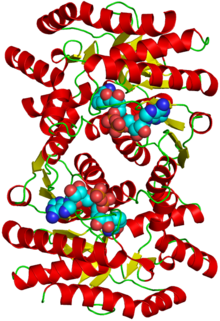Malate dehydrogenase
Malate dehydrogenase (EC 1.1.1.37) (MDH) is an enzyme that reversibly catalyzes the oxidation of malate to oxaloacetate using the reduction of NAD+ to NADH. This reaction is part of many metabolic pathways, including the citric acid cycle. Other malate dehydrogenases, which have other EC numbers and catalyze other reactions oxidizing malate, have qualified names like malate dehydrogenase (NADP+).
Several isozymes of malate dehydrogenase exist. There are two main isoforms in eukaryotic cells. One is found in the mitochondrial matrix, participating as a key enzyme in the citric acid cycle that catalyzes the oxidation of malate. The other is found in the cytoplasm, assisting the malate-aspartate shuttle with exchanging reducing equivalents so that malate can pass through the mitochondrial membrane to be transformed into oxaloacetate for further cellular processes.
Humans and most other mammals express the following two malate dehydrogenases:
The malate dehydrogenase family contains L-lactate dehydrogenase and L-2-hydroxyisocaproate dehydrogenases. L-lactate dehydrogenases catalyzes the conversion of L-lactate to pyruvate, the last step in anaerobic glycolysis. The N-terminus is a Rossmann NAD-binding fold and the C-terminus is an unusual alpha+beta fold.
In most organisms, malate dehydrogenase (MDH) exists as a homodimeric molecule and is closely related to lactate dehydrogenase (LDH) in structure. It is a large protein molecule with subunits weighing between 30 and 35 kDa. Based on the amino acid sequences, it seems that MDH has diverged into two main phylogenetic groups that closely resemble either mitochondrial isozymes or cytoplasmic/chloroplast isozymes. Because the sequence identity of malate dehydrogenase in the mitochondria is more closely related to its prokaryotic ancestors in comparison to the cytoplasmic isozyme, the theory that mitochondria and chloroplasts were developed through endosymbiosis is plausible. The amino acid sequences of archaeal MDH are more similar to that of LDH than that of MDH of other organisms. This indicates that there is a possible evolutionary linkage between lactate dehydrogenase and malate dehydrogenase.
...
Wikipedia

